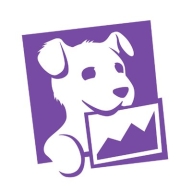

Datadog and vRealize Network Insight are prominent players in the cloud and on-premises monitoring space, respectively. Datadog holds an advantage in cloud environments due to its versatility and integration options, while vRealize Network Insight offers robust control for VMware-reliant setups.
Features: Datadog's key features include comprehensive monitoring capabilities, extensive integration options, and user-friendly dashboards that allow for seamless visibility across public, private, and hybrid clouds. It also offers real-time anomaly detection and intuitive alerting to enhance system observability. vRealize Network Insight excels in providing detailed insights and visualization of on-premises network flows, making it ideal for environments heavily using VMware products. The platform's natural language queries and intuitive dashboards simplify the monitoring of east-west data traffic in data centers.
Room for Improvement: Datadog users seek enhancements in data representation and dashboard sharing controls, alongside a more straightforward pricing model. Improved integration and logging capabilities are also desired. For vRealize Network Insight, users express a need for better navigation, enhanced interoperability with third-party products, and more detailed analytics, particularly concerning firewalls and segmentation.
Ease of Deployment and Customer Service: Datadog offers straightforward deployment across diverse cloud settings, with an impressive suite of integrations. However, users hope for more knowledgeable and timely support. vRealize Network Insight benefits from seamless integration within the VMware ecosystem, and its deployment is well-suited for on-premises configurations, garnering positive feedback for customer service through VMware's network.
Pricing and ROI: Datadog is perceived as expensive, though it provides flexible pricing models and delivers ROI by enhancing observability. Users emphasize monitoring usage to manage costs effectively. Conversely, vRealize Network Insight's cost can be a concern, attributed to additional VMware licensing fees, yet it offers valuable insights when effectively integrated with existing VMware infrastructure.
Previously we had thirteen contractors doing the monitoring for us, which is now reduced to only five.
Datadog has delivered more than its value through reduced downtime, faster recovery, and infrastructure optimization.
I believe features that would provide a lot of time savings, just enabling you to really narrow down and filter the type of frustration or user interaction that you're looking for.
When I have additional questions, the ticket is updated with actual recommendations or suggestions pointing me in the correct direction.
Overall, the entire Datadog comprehensive experience of support, onboarding, getting everything in there, and having a good line of feedback has been exceptional.
I've had a couple instances where I reached out to Datadog's support team, and they have been really super helpful and very kind, even reaching back out after resolving my issues to check if everything's going well.
It's difficult to find necessary documentation, open tickets, and get support.
We are paying too much for technical support from VMware.
Datadog's scalability has been great as it has been able to grow with our needs.
We did, as a trial, engage the AWS integration, and immediately it found all of our AWS resources and presented them to us.
Datadog's scalability is strong; we've continued to significantly grow our software, and there are processes in place to ensure that as new servers, realms, and environments are introduced, we're able to include them all in Datadog without noticing any performance issues.
Datadog is very stable, as there hasn't been any downtime or issues since I've been here, and it's always on time.
Datadog seems stable in my experience without any downtime or reliability issues.
These incidents are related to log service, indexes, and metric capturing issues.
We are managing that one but usually we have an API connector between our firewall vendor and our VMware NSX.
It would be great to see stronger AI-driven anomaly detection and predictive analytics to help identify potential issues before they impact performance.
The documentation is adequate, but team members coming into a project could benefit from more guided, interactive tutorials, ideally leveraging real-world data.
In future updates, I would like to see AI features included in Datadog for monitoring AI spend and usage to make the product more versatile and appealing for the customer.
Broadcom should improve by going back to what was working before, offering the suite of tools that clients actually use, and allowing clients to decide the best options for them.
The setup cost for Datadog is more than $100.
Everybody wants the agent installed, but we only have so many dollars to spread across, so it's been difficult for me to prioritize who will benefit from Datadog at this time.
My experience with pricing, setup cost, and licensing is that it is really expensive.
Broadcom is known for increasing product prices, making them expensive compared to what people used to pay.
Our architecture is written in several languages, and one area where Datadog particularly shines is in providing first-class support for a multitude of programming languages.
Having all that associated analytics helps me in troubleshooting by not having to bounce around to other tools, which saves me a lot of time.
Datadog was able to find the alerts and trigger to notify our team in a very prompt manner before it got worse, allowing us to promptly adjust and remediate the situation in time.
One of the biggest problems with VMware NSX is logging, and vRealize Network Insight helps by providing comprehensive logs.
| Product | Market Share (%) |
|---|---|
| Datadog | 4.8% |
| vRealize Network Insight | 0.6% |
| Other | 94.6% |


| Company Size | Count |
|---|---|
| Small Business | 80 |
| Midsize Enterprise | 46 |
| Large Enterprise | 95 |
| Company Size | Count |
|---|---|
| Small Business | 11 |
| Midsize Enterprise | 9 |
| Large Enterprise | 41 |
Datadog integrates extensive monitoring solutions with features like customizable dashboards and real-time alerting, supporting efficient system management. Its seamless integration capabilities with tools like AWS and Slack make it a critical part of cloud infrastructure monitoring.
Datadog offers centralized logging and monitoring, making troubleshooting fast and efficient. It facilitates performance tracking in cloud environments such as AWS and Azure, utilizing tools like EC2 and APM for service management. Custom metrics and alerts improve the ability to respond to issues swiftly, while real-time tools enhance system responsiveness. However, users express the need for improved query performance, a more intuitive UI, and increased integration capabilities. Concerns about the pricing model's complexity have led to calls for greater transparency and control, and additional advanced customization options are sought. Datadog's implementation requires attention to these aspects, with enhanced documentation and onboarding recommended to reduce the learning curve.
What are Datadog's Key Features?In industries like finance and technology, Datadog is implemented for its monitoring capabilities across cloud architectures. Its ability to aggregate logs and provide a unified view enhances reliability in environments demanding high performance. By leveraging real-time insights and integration with platforms like AWS and Azure, organizations in these sectors efficiently manage their cloud infrastructures, ensuring optimal performance and proactive issue resolution.
VMware vRealize Network Insight delivers intelligent operations for software-defined networking and security. It helps customers build an optimized, highly-available and secure network infrastructure across multi-cloud environments. It accelerates micro-segmentation planning and deployment, enables visibility across virtual and physical networks and provides operational views to manage and scale VMware NSX deployments.
We monitor all IT Infrastructure Monitoring reviews to prevent fraudulent reviews and keep review quality high. We do not post reviews by company employees or direct competitors. We validate each review for authenticity via cross-reference with LinkedIn, and personal follow-up with the reviewer when necessary.